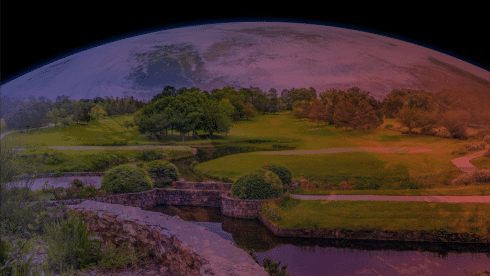Our environment has been taken out of context and domesticated in every aspect. Human dominance has been normalized and has subsequently created an unbalanced power dynamic. We’ve reached a point where we must address this power dynamic before creating truly equitable climate innovations and solutions. This reflection will do just that – it will address the domestication and institutionalization of our ecologies and analyze the power dynamic between humans and nonhumans to guide more equitable climate innovation.
It is essential to distinguish between the three main types of domestication. This reflection will focus on the domestication of our ecologies for entertainment, specifically — entertainment in the form of parks and exploitative use of wildlife, pets, and even houseplants. The second form of domestication is for education – namely through laboratory research, zoos, aquariums, and national parks. This form of domestication is hotly contested and will not be discussed at length, although to some extent, it also provides entertainment. Lastly, the domestication of ecologies for our survival, for basic needs like food and shelter, will not be discussed, despite its significant role in our ecological impact.
The domestication of our landscapes and ecologies for entertainment normalizes our dominance of the planet far more ferociously than any other form of domestication. When we institutionalize ecological dominance, we do so anthropocentrically. We, therefore, organize these ecologies in a manner that dodges any form of discomfort and encourages complacency. Nature is comfortable for us. Nature, even the word “Nature,” is comfortable for us. As Timothy Morton, a philosopher and a professor at Rice University, put it, “In the idea of pristine wilderness, we can make out the mirror image of private property.” Pristine wilderness is perhaps the quintessential concept in understanding what domestication of ecology is. We have developed parks: a version of wilderness we deem pristine that relies solely on human intervention to maintain its existence. Morton describes this as a “special kind of private property, without an owner, exhibited in a specially constructed art gallery.”
Domesticated animals are not wild animals anymore; they are now almost entirely man-made. The same is true about nature preserves, local, and even national parks: these places were once wild lands but are now tamed by human beings into something more civilized and controllable. “Nature has turned out to be a plastic knockoff of the real thing,” Morton says. These examples show how we are starting to see Nature as something separate from ourselves, which can be controlled and used for our benefit — a very dangerous mindset when dealing with climate change.
We take a wild plant into our home; now what? The houseplant is detached from its roots, i.e., its habitat, and now serves to entertain humans. Keeping it alive, at this point, relies entirely on the human. This is the power imbalance in question. A houseplant, however, isn’t as ferocious as other forms of ecological dominance.
By definition, zoos, aquariums, and laboratory facilities domesticate animals by creating a reliance on humans. According to Lori Gruen, a scholar in animal studies and philosophy, these institutions can help us better understand animals and their relationship with empathy. She cites several examples in which zoo animals exhibited empathy towards each other and later claims that Zoos also allow children who visit them to develop empathy towards the animals through “a capacity to distinguish self and other”.
Some studies suggest that children owning pets could contribute to more environmentally conscious behaviors. These behaviors, however, are primarily self-serving, anthropocentric and fade as children grow older. (Torkar, Fabijan, and Bogner). We have yet to empirically measure whether exposure to these institutions of human ecological domestication has impacted the human perception of our ecologies and whether we seek to dominate them further.
Empathy is a critical function in creating better climate change solutions. To some degree, I agree with Gruen’s thinking – and although we can create empathy through exposure to domesticated ecologies, we must also ensure that the power imbalance in these spaces is acknowledged. That the participants understand the void of consent in the pristine wilderness with which they interact. Does this mean having a pet is problematic? No. Should we feel guilty when going to a park? Not for one second. What we should realize, however, is that these are entirely manufactured and artificial. Depending on ecology’s role in our development, it could lead to more harm than good.
Undeniably, our early development impacts how we view ecology later in life. For example, if you grow up in a city surrounded by concrete buildings and tall skyscrapers, then it’s likely that you will only know about Nature through your pets and parks. However, in their current form, these institutions do not necessarily encourage an intimate relationship with Nature as much as they show how humans can manipulate it for their benefit. A zoo, for example, does this well. So does a park. A park brings a contrast to city life, something disconnected from it. Both are experiences where you, as the human, have absolute control and power that the other lifeform does not. When children grow up in environments in which humankind is in control, the idea of them no longer having this control directly challenges their core beliefs and triggers mechanisms to defend this notion. This is considered one of the primary roots of climate change denialism, which persists today.
This mindset also inspires climate technology projects that imitate the Lorax – lab-made cans of oxygen to combat pollution, plastic turf grass to mitigate floods, artificial chemical-reliant technologies for agriculture, and countless more. In Morton’s words, these solutions display the “violent, repetitive actions of someone desperate to restart a broken machine.” These solutions blatantly ignore the processes of Nature that have long occurred without human intervention. Do massive new facilities sucking up carbon dioxide in the middle of the desert mitigate climate change more than trees? Does a Tesla tunnel fix our reliance on cars compared to our agrestal urge to walk? Does a newly built platinum LEED-certified building do more good for our planet than repurposing existing structures?
These inventions are all ways human beings try to maintain this power balance. Again, in Morton’s words, “one of the things that modern society has damaged, along with ecosystems and species and the global climate, is thinking.” We think we are in control, and therefore we must do anything imaginable to stay in control. We think humans compete with nonhumans, which is not very accurate in the age of Anthropocene. We think Nature is the wastewater reservoir at the end of our subdivisions because that is the only Nature we’re exposed to. We think we must continue to live the way we live now.
So, as we look at climate solutions, we must understand that we must first shift our understanding of the power dynamic between humans and nonhumans. Even further, to discourage the distinction between the two. We then must acknowledge that doing so would bring discomfort to the complacent way we live now.
To conclude, the demise of our habitable planet will be determined by whether we choose to make a lackluster effort to further control and domesticate it or rather succumb to it or be part of it. We require a change in perspective. We must question how these institutions affect our relationship with Nature and seek more practical approaches to making an intimate connection with the natural world.





